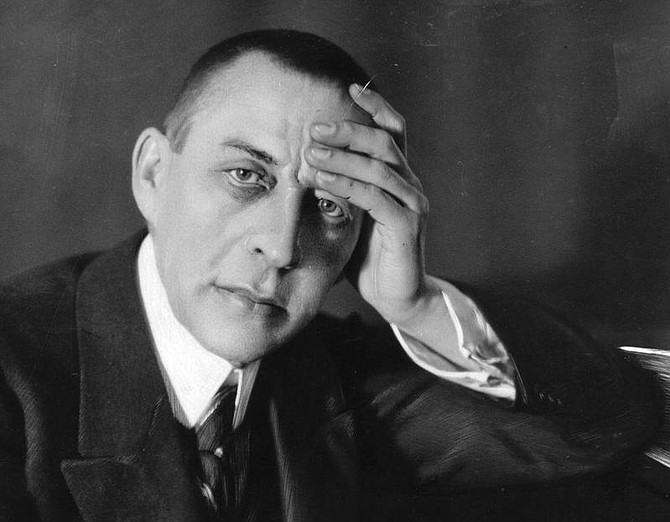 Facebook
Facebook
 X
X
 Instagram
Instagram
 TikTok
TikTok
 Youtube
Youtube

The San Diego Symphony is sounding good this season. I went to what I’m calling "The Rachmaninoff Redemption" last weekend and my sins were washed away.
The opening piece of the RR was a “between-the-wars gem” by Charles Griffes. Griffes has been called the American impressionist. It’s a fitting description. It’s what I was thinking as the orchestra performed The White Peacock.
Griffes’ dates are 1884–1920. He was dead of influenza at the age of 35 — just as his career was beginning to take shape. In 1919 The White Peacock had received its premiere at the Philadelphia Orchestra with Leopold Stokowski conducting.
The RR continued with, of all things, Rachmaninoff. The last time we heard this concerto I couldn’t wait for it to be over because, to my mind and heart, the performance of the soloist had distorted the music to such an extent that it was almost unrecognizable.
Pianist Joyce Yang shaped a performance that had it all. There was power, compassion, unbound expressions of adoration, heartbreak, and above all a musicality that aligned with Rachmaninoff.
In the opening movement the conductor, Johannes Debus, allowed the brass to poor it on pretty thick and heavy. Throughout the performance the balance of the orchestra revealed fresh and “new” textures within this masterpiece.
The second movement duet between Yang and flautist Rose Lombardo came off without a hitch. In the third movement the violas poured liquid gold all over the “big theme” when they got their chance. The violins did the same. The notes came up and out of the string section dripping the sunlight of a late autumn sunset.
After the ultra-expressiveness of Rachmaninoff we were treated to the ultra-balance and structure of Mozart’s Symphony No. 41: Jupiter. I don’t know why I continue to be surprised when Mozart holds his own when following a composer such as Rachmaninoff.
In this context it felt as though it might have made programming sense to put the Jupiter in the first half of the show and close with Rachmaninoff. After the crowded stage of the first half, the reduced Mozart orchestra looked kinda lonely up there all by themselves.
It was a trick of perception because this was — by far — the best performance of Mozart I have heard the San Diego Symphony perform. Debus and the orchestra shook the lead out and blazed through Mozart’s final symphony.
Tutti bravi.


The San Diego Symphony is sounding good this season. I went to what I’m calling "The Rachmaninoff Redemption" last weekend and my sins were washed away.
The opening piece of the RR was a “between-the-wars gem” by Charles Griffes. Griffes has been called the American impressionist. It’s a fitting description. It’s what I was thinking as the orchestra performed The White Peacock.
Griffes’ dates are 1884–1920. He was dead of influenza at the age of 35 — just as his career was beginning to take shape. In 1919 The White Peacock had received its premiere at the Philadelphia Orchestra with Leopold Stokowski conducting.
The RR continued with, of all things, Rachmaninoff. The last time we heard this concerto I couldn’t wait for it to be over because, to my mind and heart, the performance of the soloist had distorted the music to such an extent that it was almost unrecognizable.
Pianist Joyce Yang shaped a performance that had it all. There was power, compassion, unbound expressions of adoration, heartbreak, and above all a musicality that aligned with Rachmaninoff.
In the opening movement the conductor, Johannes Debus, allowed the brass to poor it on pretty thick and heavy. Throughout the performance the balance of the orchestra revealed fresh and “new” textures within this masterpiece.
The second movement duet between Yang and flautist Rose Lombardo came off without a hitch. In the third movement the violas poured liquid gold all over the “big theme” when they got their chance. The violins did the same. The notes came up and out of the string section dripping the sunlight of a late autumn sunset.
After the ultra-expressiveness of Rachmaninoff we were treated to the ultra-balance and structure of Mozart’s Symphony No. 41: Jupiter. I don’t know why I continue to be surprised when Mozart holds his own when following a composer such as Rachmaninoff.
In this context it felt as though it might have made programming sense to put the Jupiter in the first half of the show and close with Rachmaninoff. After the crowded stage of the first half, the reduced Mozart orchestra looked kinda lonely up there all by themselves.
It was a trick of perception because this was — by far — the best performance of Mozart I have heard the San Diego Symphony perform. Debus and the orchestra shook the lead out and blazed through Mozart’s final symphony.
Tutti bravi.
Comments